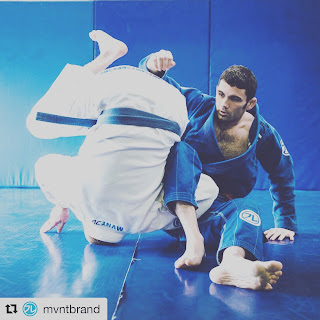After my win in Italy at the end of 2003 I was keen to get back in and have another go as soon as possible. Unfortunately, there weren't as many opportunities to fight or MMA events taking place at that stage. I kept myself busy by competing in BJJ, KSBO amatuer MMA events and also some Jiu Jitsu Kumite events which were mixture of semi contact karate and grappling. I was also pretty busy at this time with work and exams, but as soon as my exams were over I made a big push to get matched up for as many MMA matches as I could get.
I had four pro MMA fights in four months from June to September 2004. I won three of those and the fourth was given as a draw however it was one of my most dominant ever fights. I took my opponent down and punched and elbowed him from guard for three straight rounds. In between these fights I also competed in regularly in BJJ and grappling events.
I found all my own matches by contacting promoters and offering to fight anyone they had at a similar weights. Then a group of us would head off on a road trip on Saturday to the other side of the country. Weigh in, have a fight then drive home later that night. Looking back now that probably wasn't the best way to manage a Fight career but I wanted to keep improving and to me that meant testing myself and staying active. I had to fight whoever was offered and keep working to get better between every fight.
Throughout all these fights and during the training camps I was suffering from instability in my knee. I could still and compete but it would pop out every now and again (including during one of my fights) and I needed to keep it heavily taped up when I fought. At the end of 2004 I was booked in to get ACL reconstruction surgery and this put my fight career temporarily on hold.
In Feb 2005 I had a full ACL reconstruction. This can usually take a long time to recover from but I wanted to make sure I was fight ready as soon as possible after the surgery. The first two weeks I was off work stuck at home wearing a huge knee brace and using crutches, as soon as I could walk again I got back to light weight training and also did rehab physio sessions once a week. About a month after the surgery I got back to boxing, however focusing more on punching and not so much footwork. During this time I did most of my boxing training at the Fitzroy Lodge gym in south London.
I also had more exams around May of this year so once my exams were done I wanted to return to full training. Approximately five months after my knee surgery I was ready to get back to grappling training and was able to compete in a grappling tournament again a few weeks later.
Around this time I also got offered a shot to fight on a new MMA promotion which would take place in London in October. I was very keen to get back in and fight to make up for my lost time. In the months leading up to this fight I also went on two training trips, firstly to Amsterdam where I got to train with many legends of Dutch Kickboxing including Ernesto Hoost, and then a few months later I traveled to Brazil where I trained at Brazilian Top Team, which was the leading MMA team in the world at that time.
My first fight back after surgery was against Ciro Gallo in York Hall, Bethnal green. I dropped him with a punch right at the start of the round then got a Judo style Turtle rolling armbar. I was happy with the result of this fight as I had been out of full training and fighting for so long. However as always when I felt a fight was too easy I also had a slight feeling of disappointment that it wasn't enough of a challenge and that I had wasted several months of training and preparation but hadn't really tested myself. However I was never really the type of fighter to pick and choose my opponents or even to bother finding out much about them before i stepped into the ring. I just fought whoever was in front of me. I didn't look as MMA fighting as a career or even a sport. I just looked on it as a realistic way of testing my martial arts skills. If you get attacked on the street you don't get to pick and choose who you get attacked by, you don't ask for someone who is closer to your weight or has a similar record and you certainly don't ask your attacker to come back on another day because you've got a cold or sore elbow.












